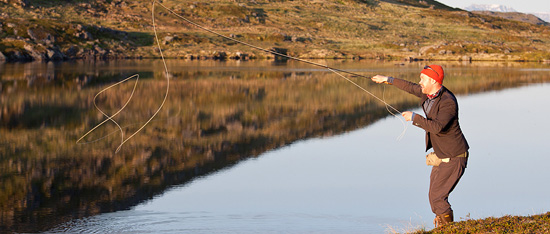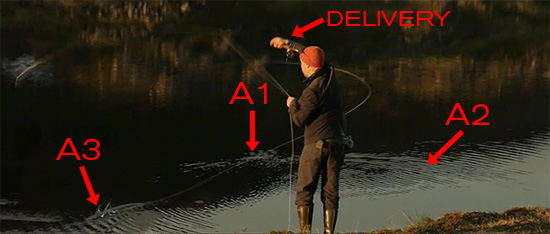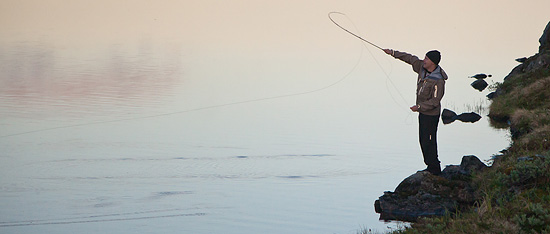I was recently made aware of an exciting new development in fly casting from the gentlemen here at Jazz & Fly Fishing: The NEW, IMPROVED J&FF Shadow Cast. This cast takes the signature technique from A River Runs Through It in a completely new direction, and serves to finally tie together the broad, sweeping strokes of old-school, Montana-style overhead casting and modern, Scandinavian-style “trick” Speys. This unrestrained approach is game-changing, creating a serious discussion of technique in a fly-casting community longing for a new generation of advanced presentation skills.
Being both a “shadow caster” and a Spey caster, I was at first overwhelmed by the demonstration video shown here. Then, my technical and critical minds kicked in and I realized “Of course!” Rarely does one have such “a-ha” moments like this, but it was obvious that the carefully synchronized blend of Shadow and Spey had given birth to a form of casting that is unique and “special” in a whole new way.
The cast (in its various iterations and sub-forms shown here at J&FF) plays like an eloquent series of notes, with highs and lows bridged by sweeping movements that culminate in a subtle, effective delivery to the listener/angler. It is easy to see how the four gentlemen behind the “Jazz” part of this effort were able to translate their musical aptitude into creating “magic” with a fly line.
Looked at critically, there are a number of elements that come together to make this cast work properly, and with the right combination of stealth and fish-attracting motion. I have been practicing the “A” version of the J&FF Shadow Cast/Spey here in the big steelhead rivers of the Pacific Northwest, and three things really jump out at me. The first is the need for the proper aerial structure to set up the Triple Anchor (coming up!). This movement can vary depending on the wind (upstream, downstream or across-stream) and which river bank you’re on (right or left or wading in the middle). When practicing in calm conditions, though, this aerial display can be initiated directly in front of the caster.
To get the most from the “A” variation, the rod tip must be moved like a conductor’s baton to carve a “double S” shape that both lifts the line from the water and creates enough tension in the system to place the Triple Anchor properly. These “double S” shaped moves also create the signature “S” for Shadow (twice!), which is a visual element that is both unexpected and fascinating. Just remember in all of this that the line follows the rod tip. Retain control of your range of motion and energy application at all times (watch the video as a good example), and this “double S” practically draws itself. A superb example is seen in this still frame:

The important "double S" move that sets-up the initial part of the J&FF Shadow Cast. The "double S" lifts the fly, provides line tension, and creates the signature "S" for Shadow aspect (twice, which is pretty cool). Note that this is the "A" variation, other variations may adjust this "S" shape to be more of a "SXZ," "XSZ", "SSX," or similar.
Once the line is properly tensioned by this series of movements (and the fly is now airborne), it can be placed into the key series of Triple Anchors (designated A1, A2, and A3 for the sake of clarity—see the photo below). This Triple Anchor sequence is casting brilliance in action. The three touch-downs are only brief (this is a “splash-and-go” style of casting), but they serve several purposes: 1) They compound the tension over and over, storing massive elastic energy in the line and loading the rod repeatedly; 2) The splashes and ripples they create are the analogue to the shadow of the fly in the traditional (and now out-dated) Shadow Cast. In other words, they attract the fish by building a sense of playful insects on the water’s surface); and 3) They set up a scenario that allows the caster to drop the rod tip very low when making the D-Loop. This last part is key to the stealth presentation that the J&FF Shadow Cast provides. The super-low (actually falling) D-Loop keeps the line out of sight of the now-attracted fish, and also sets up a high forward delivery (see the twisting, sweeping motion of the rod hand needed to achieve this in the photo below). This high-aimed delivery is key, I have determined, in that it allows the line to fall in a massively drag-reducing series of coils, curves and puddles. Brilliant! No drag, soft landing, and it’s fish on!

A1-A3 are the Triple Anchors shown in sequence. Note also the rising delivery cast made after the always-falling D-Loop. The always-falling D-Loop is a key to the fishing effectiveness of this cast!
In closing, the brilliant chaps at J&FF have take two classical forms of fly casting—one from literature and the silver screen, the other from the icy waters of fabled salmon rivers—and made something never before seen. J&FF’s musical background also seems to have helped them construct the timing necessary to make this a reality for actual fishing. The fly-casting world will never be the same again, that’s for certain, and I suspect that soon everyone from British chalk-stream anglers to American big-river guides will be putting the Very Serious J&FF Shadow Cast through its paces.
Signing off until next time—good casting and tight lines to all!
Jason Borger


Brilliant!
Grunde–Thanks, my friend. This was almost too easy to write (and I could have gone on and on, but I had to cut myself off). It seems that not everyone has gotten the joke yet, but hopefully the exploration above will be far enough out-of-bounds that it will cause a bit of a pause… 😉
Excellent in-depth writing, Jason 🙂
André B
André—Thanks for that. Did my best to really dig into the essence of this “dazzling” new technique!
“I realized, that in the time I was away, my brother had become an artist”